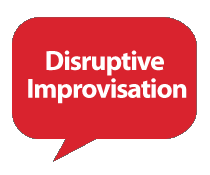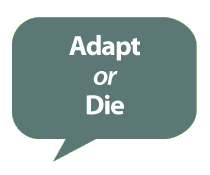
The Break Room
Here in The Break Room we take a few moments a couple times a month to offer insight that connects applied improvisation to the challenges – cultural and otherwise – that organizations, companies, businesses of all shapes and sizes face.
Sit down. Grab a cup of coffee. Take a break. You probably need it.

Summary: Visionaries like Clayton Christensen know that new technologies and ideas not only have the power to transform businesses, but the way entire societies view themselves. How can we prepare for “disruptive innovation?” Learn flexibility. How? By learning to improvise.
If Harvard Business School professor Clayton Christensen’s concept of “Disruptive Innovation” taught us anything, it’s that the world as we know it won’t be the same tomorrow as it is today—nor will it be what we imagine. As Christensen points out, disruptive technologies, ideas, and business cultures have the potential to radically transform society as a whole, and often do.
The result? High profile products, companies, business models, and entire markets that were once secure become obsolete.
Disruptive innovation has significant implications for the business world. Companies and organizations that aren’t flexible and fully prepared to either innovate or accommodate innovation simply won’t survive. In fact, the business landscape is dotted with technologies, companies, even ways of seeing the world that are no longer functional or tenable.

You may be familiar with the famous Chinese curse, “May you live in interesting times.” For businesses, and those who manage them, these certainly are very interesting times. A critical question that arises is this: How do you manage—or, more importantly, manage people—during this tremendous age of technological and cultural upheaval?
One solution is this: Stop teaching people what to think. Instead, teach them how to think. And even better, teach them how to think in ways that allow them to create and seize unanticipated opportunities.
Teach them improv comedy.
Yeah, that’s right: improv comedy. Or what you might call “disruptive improvisation.”
“Don’t judge a book by its cover.”
At first glance, improv comedy looks like play. And to be sure, it is. Its most famous practitioners are some of the funniest people on the planet—Will Ferrell, Amy Poehler, Tina Fey, Stephen Colbert. Only when we consider bringing improv to the workplace, most write it off as superficial fun and games, and lump it in with the touchy-feely stuff you do (or watch other people do) on your organization’s annual retreat that doesn’t have any real business benefit.
Nothing could be further from the truth.

Improv comedy is a form of theater where most or all of what is performed is created at the moment it is performed. In its purest form, the dialogue, the action, the story, and the characters are created collaboratively by the players as the improvisation unfolds.
To do it, and to do it well, improvisers have to adopt a collaborative mindset that involves accepting and adding in the moment—quickly recognizing contexts and adapting to serve them, quickly recognizing patterns and responding to heighten them (since comedy travels in patterns), and quickly understanding the dynamic relationship you suddenly find yourself in and making a character choice that helps enhance it.
Improv comedy is not for those sensitive to loud noises and bright lights, to be sure. Rather, it’s for people who have trained themselves in a very specific discipline that makes it possible to think and react in very specific ways.
Improv forces its performers to do exactly what’s required for innovation to occur:
- Check your ego at the door.
- Toss aside what was “true” before for a brand new “truth” that’s emerged.
- Serve the collective, knowing that what works best is a collaborative effort rather than the vision of just one person.

Here’s another way of saying it: improvisers are taught to innovate in the moment, on the fly, and as quickly as possible. Improvisers understand that “reality” and “truth” are in a constant state of flux, and that we’ll only be successful by our willingness to recognize and adapt.
Imagine if leaders, teams, and even entire organizations thought the same way improvisers did. They’d be innovative, visionary, and insightful. Disruptive, even.
And disruptive improvisers not only survive, they thrive.
